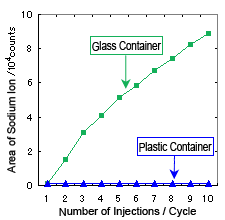Key Considerations for Daily Analysis: Ion Chromatography - Part2
The previous page on key considerations for ion chromatography discussed contamination and handling columns. This page will discuss pretreating samples for ion chromatography.
Sample Pretreatment
To reliably analyze target components in samples with good sensitivity, it is necessary to pretreat samples to minimize the influence of coexisting components and avoid clogging flow lines or column deterioration. The following describes some of the representative pretreatment methods for ion chromatography.
Filtration
This is the most common method used to prevent clogging columns and flow lines. It uses a disposable membrane filter with a 0.2 µm to 0.5 µm pore size. Various types of filters are available, but one designed for ion chromatography, which involves lower inorganic ion contamination levels, should be used. If samples contain large amounts of insolubles, precipitate the insolubles by centrifuge in advance to achieve more efficient filtering.
Ultrafiltration
Ultrafiltration is a convenient method for removing proteins and other organic substances that cannot be removed with a membrane filter. Filters are available for removing molecular weights ranging approximately from 5000 to 100,000. Disposable models are also available on the market. These filters can be generally divided into two types. One is pressurized with a syringe and the other is placed in a centrifuge.
Dilution
Normally either ion exchange water or mobile phase solution is used for dilution. Of course, the solution used for dilution must not contain any target components, so always measure a blank sample of the solution. Also, the dilution rate must be decided after considering the load to the column used and allowable quantitative range.
An effective way to avoid accidentally damaging the columns is to first measure a sample diluted 50 to 100 times and observe the results.
Dissolution and Extraction
Solid samples or organic solvents are difficult to analyze using ion chromatography, which does not ionize samples, without extracting or dissolving them into an aqueous solution. For solid samples with poor water solubility, first dissolve the sample in organic solvent, then extract them in water.
To measure unknown samples, test a mixture in advance to make sure they do not precipitate in the mobile phase when injected.
Mini-Columns
This method involves chemically removing unwanted substances using mini-columns packed with ion exchange resins and hydrophobic packing materials. In general, there are five types. (These are also used in combination.)
| 1) | H+ type strong cation exchange resin
|
| 2) | OH- type strong anion exchange resin
|
| 3) | Hydrophobic packing material
|
| 4) | Ag+ type strong anion exchange resin
|
| 5) | Ba2+ type strong cation exchange resin
|
|
|
Always perform an additive recovery rate test when using these pretreatment methods. |
|
|
Perform a blank measurement in case there are any peaks that appear in unexpected positions or baseline fluctuations occur from the mini-column elute. |
Preparing Standard Solutions

Change in Sodium Ions Leached from Vials over Time
Storage Containers
The graph to the right shows the change in peak area value of the sodium ion as sample vials of mobile phase (6-mM methanesulfonate) are repeatedly injected into a suppressor ion chromatograph. Two types of sample vials were used, glass and polyethylene, and each was cleaned by soaking in purified water before use. In glass containers, the concentration increased over time.
As this shows, it is important to be aware that acidic solutions in contact with glass can leach sodium ions or other substances from the glass, which can influence analyses.
In particular, for highly-sensitive measurements, avoid leaving samples in contact with glass equipment for extended periods. Polypropylene or polyethylene containers are most commonly used to store samples. Whatever material is used, always clean new containers before use.
Sample Solvents
Magnesium ions and calcium ions cause precipitation of hydroxides in basic aqueous solutions. This even occurs slowly in purified water that has not been pH-adjusted. As a result, the concentration of magnesium or calcium ions decrease over time. To prevent that, it is useful to prepare solutions using a dilute acidic aqueous solution. However, to prevent peak broadening, the acid concentration of the standard solution should probably be lower than the acid concentration of the mobile phase. In many cases, commercial standard solutions are 0.1- to 1-M nitric acid or hydrochloric acid solutions. Such solutions can probably be diluted with purified water without a problem, if the dilution rate is low.
Making the sample solvent acidic means that the competing H+ ions will inhibit the ions being measured from adsorbing to the container and instrument, which will provide the additional benefit of preventing contamination. To measure cations with high sensitivity, we recommend preparing samples in dilute aqueous acid solutions. (Nt)


